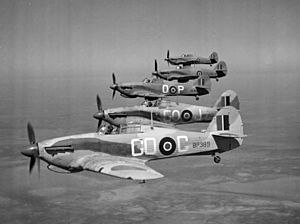No. 94 Squadron RAF facts for kids
Quick facts for kids No. 94 Squadron RAF |
|
|---|---|
| Active | 1 August 1917–30 June 1919 26 March 1939–20 April 1945 15 December 1950–15 September 1957 1 October 1960–30 June 1963 |
| Country | |
| Branch | |
| Motto(s) | "Avenge" |
| Equipment | Sopwith Camel (1917–1918) S.E.5A's (1918–1919) Gloster Gladiator (1939–1941) Hawker Hurricane (1941–1942;1942–1944 ) Curtiss P-40 (1942) Supermarine Spitfire (1944–1945) de Havilland Vampire (1950–1954) de Havilland Venom (1954–1957) Bristol Bloodhound (1960–1963) |
| Engagements | First World War |
| Commanders | |
| Notable commanders |
Howard Mayers Russell Foskett Arthur Clowes |
| Insignia | |
| Squadron badge heraldry | A wolf's head erased. |
| Squadron codes | ZG Allocated Apr 1939 - Sep 1939 GO Sep 1939 - Apr 1945 FZ Feb 1942 - May 1942 A Dec 1950 - 1955 |
No. 94 Squadron RAF was a special group of pilots and planes in the Royal Air Force. They played a part in both World War I and World War II. This squadron was actually created and reformed four different times throughout history!
No. 94 Squadron in World War I
The squadron first started on 1 August 1917 at Harling Road. It was a training group for pilots learning to fly the Sopwith Camel plane.
In May 1918, the squadron got ready for combat. They moved to France in October with their new S.E.5A planes. However, the war was ending soon. So, the squadron returned to the UK in February 1919 without fighting any battles. They were officially closed down on 30 June 1919 at Bramham Moor Aerodrome.
No. 94 Squadron in World War II
On 26 March 1939, the squadron was started again. This time, they were based at RAF Khormaksar to protect the Aden Protectorate. They flew Gloster Gladiator fighter planes.
In April 1941, the squadron gave its operations and planes to the South African Air Force. Then, they moved to Egypt. In May, they received new Hawker Hurricane planes.
As part of the Western Desert campaign, the squadron flew patrols both day and night. In November, they also started attacking targets on the ground. In February 1942, they switched to flying Kittyhawk planes. They used these for fighter patrols over the desert.
By May, the squadron was pulled back from the front lines. They received Hurricanes again for defense duties. In February 1944, the squadron changed to Supermarine Spitfire planes. They used these for flights over Crete. In September, the squadron moved to Greece. In December 1944, they helped the Army during fights in Athens. The squadron was closed down on 20 April 1945.
No. 94 Squadron in the Cold War
The squadron was formed a third time on 15 December 1950. They were based at RAF Celle in Germany. They flew De Havilland Vampire fighter-bomber planes.
In January 1954, the squadron got new De Havilland Venom planes. They were closed down again on 15 September 1957.
The squadron was reformed for the fourth time on 1 October 1960. This time, they were at RAF Misson, near RAF Finningley. They became an air defense missile unit, using Bristol Bloodhound missiles. This unit was closed down on 30 June 1963.


